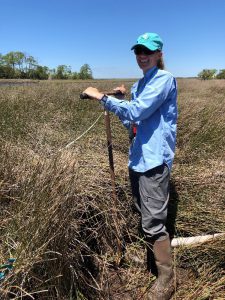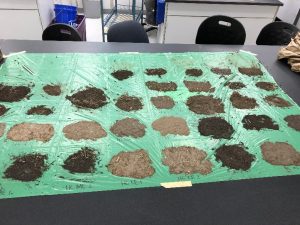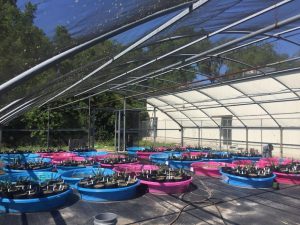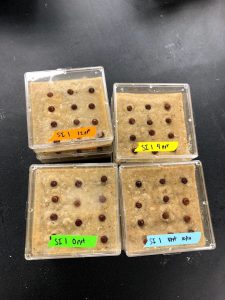Written by Stephanie Verhulst, Graduate Research Assistant at UF IFAS Environmental Horticulture

Stephanie is currently working on three projects focused on the role salinity and inundation has on salt marsh vegetation and coastal forest tree species. Her work includes controlled experiments in the Environmental Horticulture greenhouse complex at the UF campus and field experiments in tidal creeks along the Florida Gulf coast. These activities support the Florida Fish and Wildlife Conservation Commission State Wildlife Grant “Linking salinity and sea level to salt marsh productivity and coastal forest die-off” (2016-2020).

Stephanie initiated her 2019 field season in May 2019 to assess salt marsh vegetation growth, productivity, and physiological stress signals. She designed her study to cover 12 different Juncus dominated salt marshes extended from the Cedar Key area to creek systems north of Steinhatchee. Her goal was to identify abiotic parameters that influence biotic responses to salt stress. At her field sites, she measured and collected Juncus, installed groundwater monitoring wells, collected soil samples for soil salinity, nutrient levels, and texture analysis. She completed her field season at the end of June 2019 where she then focused on processing the samples for analysis.

During the 2019 field season, Stephanie mentored a NCBS undergraduate student intern, Sarah Tevlin, on her project “Variation in Black Needle Rush (Juncus roemerianus) biomass along the Big Bend region, influenced by distance to coast”. Stephanie guided Sarah through the project steps of design, sample collection and processing, and data analysis.
Stephanie completed a seed germination experiment in March 2019 where she assessed the germination responses of Sabal palmetto seeds when exposed to various salinities. This study was in conjunction with a pilot study in the greenhouse complex where young palm and cedar trees were treated with similar salinities. This work was presented at the 2019 annual meeting of the Society of Wetland Scientists.


In April 2019, Stephanie setup a full coastal forest experiment in the greenhouse complex to study the effects of salinity and inundation on the growth and physiological responses of different aged palm seedlings. The project ran through the end of October 2019.

Stephanie is working under a State Wildlife Grant issued by Florida Fish and Wildlife and U.S. Fish and Wildlife Service. Stephanie and Dr. Carrie Adams met with agency representatives at a tidal creek field site in November 2019 to observe site conditions, grant progress, and discuss preliminary results.
 0
0
